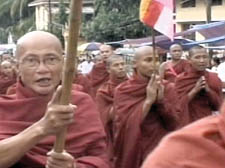|
|
 |
| |

Protesting monks take to the streets in 2007 to protest in a scene from Burma VJ |
Bravery of film-makers in face of Burmese brutality
BURMA VJ
Directed by Anders Ostergaard
Certificate 12a
THE body of the monk lies face down in the creek. His red and purple robes are dark, stained by grimy waters, dirt from the banks and his own blood. People gather, but no one has yet moved him, fearful of the secret police milling around, frightened that if they give the monk dignity in death they too could face a similar fate.
It is Burma, September 2007, and this is the fallout from the peaceful demonstrations by monks and students against the brutal military junta that has ruled the country for 45 years.
The story of the demonstrations is told in Burma VJ. Put together by a crew of video journalists and smuggled out of the country, it is extremely uncomfortable viewing and cannot help but fill you with anger, and then deep sadness that any human being could be so detached from compassion that they would act like this to another.
In those rain-filled days of September, people took to the streets, prompted by an overnight doubling of fuel prices. They were joined by the country’s moral guardians, 400,000 purple-robed monks. Together, they faced the might of the Burmese military.
The demonstrations became known as the Saffron Revolution – but the junta, with its network of undercover agents backed up by heavily armed soldiers, were not going to take it. As the street demonstrations massed popular support and it seemed the regime may be wobbling, the powers struck back, brutally, murderously.
Japanese cameraman Kenji Nagai filmed the protests, but within moments a soldier shot him dead.
His death might have gone unnoticed as the Burmese government told Japan he had been hit by a stray bullet. But the truth would emerge because of the video journalists who filmed the murder.
Joshua, aged 29, a college graduate, captured much of the footage. The terrible toll making this film has taken on him is obvious. In Thailand, where he fled to safety, he can’t sleep at night. When he hears the put-putting of a motorbike – something that occurs every minute – the hairs on his neck stand up, as the Burmese military use bikes to arrest people.
Much of the film features muffled conversations and views of the inside of handbags – the dangers mean much of the filming is done at knee height. It is extraordinary. One scene shows a student holding a flag and being told by others that they have to run as the army is beginning to attack. He simply says: “Those who are not afraid to die, come with me to the front.”
Images like this will make you think about what we are doing to forward peace, justice and freedom. While our troops slug it out in Afghanistan, and our leaders were happy to go like puppy dogs into Iraq, regimes like those in Burma abuse their people with not much more than furrowed brows from our politicians and media.
Burma was once part of the British Empire. The strength of its army and civil service, the twin components of military rule, are the legacy of our time there.
As this superb film shows, this regime is a bloody stain on the 21st century and we hang our heads in shame that the international community seem so utterly powerless to step in.
Jailed: VJ voices are kept behind bars
THE people who helped make Burma VJ possible are in prison at the moment: their names are Htin Kyaw, Su Su Nway, Ohn Than, Si Thu Maung, Ko Win Maw.
They all played vital roles shooting the film and getting the footage out. They are in Burmese prisons and have been handed stiff sentences for “crimes” including penning a song in honour of democracy figurehead Aung San Suu Kyi, and being involved in student groups. Even the families of these five brave people have been arrested: the parents of Si Thu Maung were given six-month sentences for “not opening the door quickly enough” when the police came looking for their son. |
 |
|
 |
| |
|
 |
|

